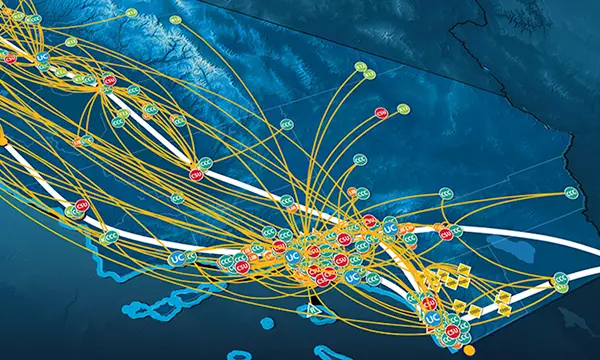- About
- Network
- Community
- Initiatives
- News
- Events
- Blog
- Publications

Life Inside CENIC: Nick Plunkett & Internet Peering Services
Categories RENS & NRENS The CENIC Community
Tags calren internet services life inside cenic peering research and education settlement free interconnection

Nick Plunkett, a network engineer in CENIC’s Internet Services team, spends most days working with network peers such as Facebook, Google, Amazon, and Microsoft to build and maintain high-quality and high-capacity settlement-free interconnection (SFI) points between their networks and CENIC’s. Since the inception of the California Research and Education Network (CalREN), CENIC has cultivated peering relationships, maintaining and adding routes and connection points to enhance network performance, increase cost savings, and expand collaboration opportunities for CENIC members.
“I help make sure that everything our associates demand from our network — whether that is the newest cloud computing services or watching a YouTube video — works and is delivered in the best way possible,” Plunkett said. A department of just two staff members, Internet Services is overseen by Associate Director Darrell Newcomb, who led the development of SFI at CENIC and continues to guide its success.
Peering requires physical interconnection of the networks, an exchange of routing information, and is accompanied by peering agreements. CENIC works with hundreds of peers from both research and commodity networks, and has built out some of the highest-quality direct connectivity available across all R&E networks to all major cloud providers. This "built-in" connectivity generally obviates the need for CENIC members to pay for expensive direct connections to those cloud providers. CENIC’s peering infrastructure supports researchers moving their computing to the cloud, campus administrators storing data off-site, and students using online and interactive resources.
“For instance, if you were trying to download an update for your iPhone, on many networks you would have to go over paid ‘transit’ connectivity to access Apple’s network to get the update file from Apple's network to your device,” Plunkett said. “Instead, we work with partners at Apple to build settlement-free paths between our networks where neither entity pays the other in order to achieve better, more direct, lower-cost connectivity for our members.”
Year after year, CENIC has expanded peering and exchange relationships, and increased network capacity to keep pace with demand. In 2018, capacity increased by 40%. Part of Plunkett’s work involves analyzing historical data and keeping close tabs on industry trends to anticipate and stay ahead of network demand. “As we add more institutions onto CalREN, and as people consume more bandwidth in general, we have to stay ahead of those demands and build the network out on our side,” Plunkett said. “Every year, people are watching more videos, consuming more content, they’re working more in the cloud, and we have to continue to stay ahead to maintain connectivity.” Plunkett cited network demand and resource allocation as two of his biggest professional challenges.
After completing a Cisco certification at a local community college, Plunkett began his career at CENIC in 2013 as an intern in the Network Operations Center. He was promoted to a full-time trainee, then to a network operations engineer, and then again in 2016 to his current position. The ability to make a big impact is a large part of what drives him.
“Seeing a child at an elementary school use a tablet in a computer lab to access online educational content or a researcher at a university use the resources we've been able to build for them is rewarding,” Plunkett said. “Knowing I had a hand in making that work and improving the life of someone in some way is very fulfilling and keeps me coming back every day.”
Plunkett said communication has always driven humanity forward, and the Internet is the next step forward into the future. He said he is always striving to ensure equal access and efficient use of resources, and to make things better for members in general. The best part about working for CENIC, he said, is that he gets to work with great people, do interesting work, and get professional support.
The Internet Services team plays an integral part in CENIC’s work serving over 20 million users across California, including the vast majority of K-20 students together with educators, researchers, and individuals at other vital public-serving institutions.
Related blog posts
The Big Game Is Big Data: How CENIC and the California Research and Education Network Support Member Athletics
When Fresno State needed to connect to Pac-12 Enterprises to broadcast a live football game over CBS, the Chancellor's Office reached out to CENIC for what Pac-12 later called the smoothest turn-up they've ever experienced.
Enabling Network-Based Collaboration Around the World: A Tour of CENIC and Partner Network Maps
On the Network Maps page at the CENIC website, you’ll find maps of all the networks, peering facilities, and exchanges to which CalREN connects, showing how thousands of CENIC member institutions connect to CalREN and to colleagues all over the globe.


